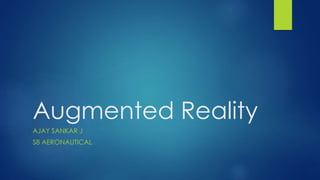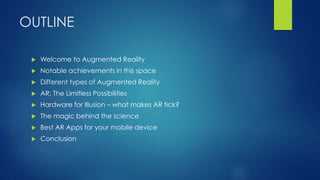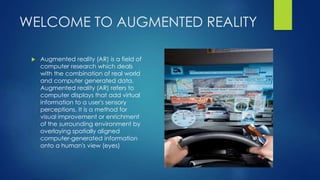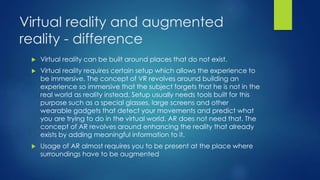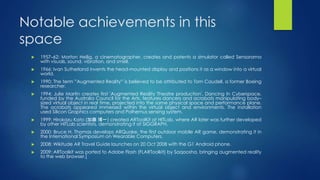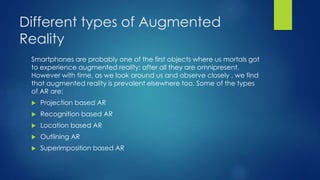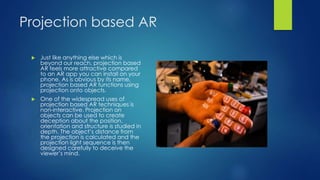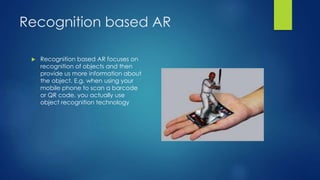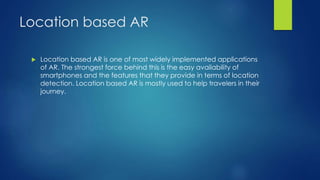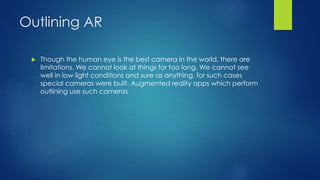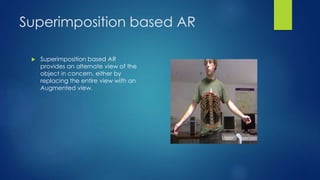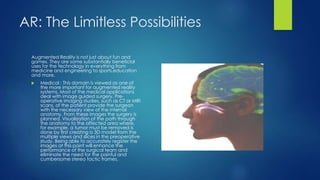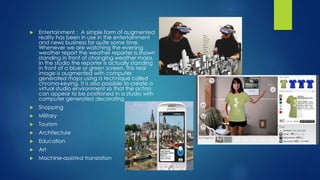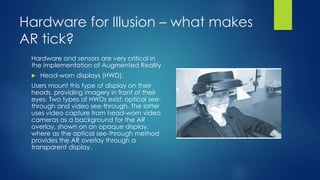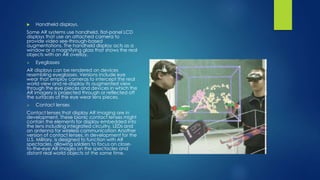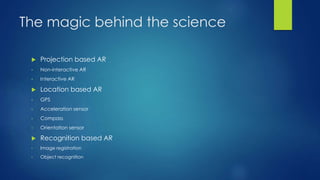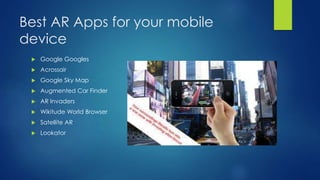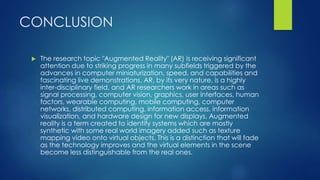Augmented Reality
- 1. Augmented Reality AJAY SANKAR J S8 AERONAUTICAL
- 2. OUTLINE Welcome to Augmented Reality Notable achievements in this space Different types of Augmented Reality AR: The Limitless Possibilities Hardware for Illusion – what makes AR tick? The magic behind the science Best AR Apps for your mobile device Conclusion
- 3. WELCOME TO AUGMENTED REALITY Augmented reality (AR) is a field of computer research which deals with the combination of real world and computer generated data. Augmented reality (AR) refers to computer displays that add virtual information to a user's sensory perceptions. It is a method for visual improvement or enrichment of the surrounding environment by overlaying spatially aligned computer-generated information onto a human's view (eyes)
- 4. Virtual reality and augmented reality - difference Virtual reality can be built around places that do not exist. Virtual reality requires certain setup which allows the experience to be immersive. The concept of VR revolves around building an experience so immersive that the subject forgets that he is not in the real world as reality instead. Setup usually needs tools built for this purpose such as a special glasses, large screens and other wearable gadgets that detect your movements and predict what you are trying to do in the virtual world. AR does not need that. The concept of AR revolves around enhancing the reality that already exists by adding meaningful information to it. Usage of AR almost requires you to be present at the place where surroundings have to be augmented
- 5. Notable achievements in this space 1957–62: Morton Heilig, a cinematographer, creates and patents a simulator called Sensorama with visuals, sound, vibration, and smell. 1966: Ivan Sutherland invents the head-mounted display and positions it as a window into a virtual world. 1990: The term "'Augmented Reality'" is believed to be attributed to Tom Caudell, a former Boeing researcher. 1994: Julie Martin creates first 'Augmented Reality Theatre production', Dancing In Cyberspace, funded by the Australia Council for the Arts, features dancers and acrobats manipulating body– sized virtual object in real time, projected into the same physical space and performance plane. The acrobats appeared immersed within the virtual object and environments. The installation used Silicon Graphics computers and Polhemus sensing system. 1999: Hirokazu Kato (加藤 博一) created ARToolKit at HITLab, where AR later was further developed by other HITLab scientists, demonstrating it at SIGGRAPH. 2000: Bruce H. Thomas develops ARQuake, the first outdoor mobile AR game, demonstrating it in the International Symposium on Wearable Computers. 2008: Wikitude AR Travel Guide launches on 20 Oct 2008 with the G1 Android phone. 2009: ARToolkit was ported to Adobe Flash (FLARToolkit) by Saqoosha, bringing augmented reality to the web browser.[
- 6. Different types of Augmented Reality Smartphones are probably one of the first objects where us mortals got to experience augmented reality; after all they are omnipresent. However with time, as we look around us and observe closely , we find that augmented reality is prevalent elsewhere too. Some of the types of AR are: Projection based AR Recognition based AR Location based AR Outlining AR Superimposition based AR
- 7. Projection based AR Just like anything else which is beyond our reach, projection based AR feels more attractive compared to an AR app you can install on your phone. As is obvious by its name, projection based AR functions using projection onto objects. One of the widespread uses of projection based AR techniques is non-interactive. Projection on objects can be used to create deception about the position, orientation and structure is studied in depth. The object’s distance from the projection is calculated and the projection light sequence is then designed carefully to deceive the viewer’s mind.
- 8. Recognition based AR Recognition based AR focuses on recognition of objects and then provide us more information about the object. E.g. when using your mobile phone to scan a barcode or QR code, you actually use object recognition technology
- 9. Location based AR Location based AR is one of most widely implemented applications of AR. The strongest force behind this is the easy availability of smartphones and the features that they provide in terms of location detection. Location based AR is mostly used to help travelers in their journey.
- 10. Outlining AR Though the human eye is the best camera in the world, there are limitations. We cannot look at things for too long. We cannot see well in low light conditions and sure as anything, for such cases special cameras were built. Augmented reality apps which perform outlining use such cameras
- 11. Superimposition based AR Superimposition based AR provides an alternate view of the object in concern, either by replacing the entire view with an Augmented view.
- 12. AR: The Limitless Possibilities Augmented Reality is not just about fun and games. They are some substantially beneficial uses for the technology in everything from medicine and engineering to sports,education and more. Medical : This domain is viewed as one of the more important for augmented reality systems. Most of the medical applications deal with image guided surgery. Pre- operative imaging studies, such as CT or MRI scans, of the patient provide the surgeon with the necessary view of the internal anatomy. From these images the surgery is planned. Visualization of the path through the anatomy to the affected area where, for example, a tumor must be removed is done by first creating a 3D model from the multiple views and slices in the preoperative study. Being able to accurately register the images at this point will enhance the performance of the surgical team and eliminate the need for the painful and cumbersome stereo tactic frames.
- 13. Entertainment : A simple form of augmented reality has been in use in the entertainment and news business for quite some time. Whenever we are watching the evening weather report the weather reporter is shown standing in front of changing weather maps. In the studio the reporter is actually standing in front of a blue or green screen. This real image is augmented with computer generated maps using a technique called chroma-keying. It is also possible to create a virtual studio environment so that the actors can appear to be positioned in a studio with computer generated decorating Shopping Military Tourism Architecture Education Art Machine-assisted translation
- 14. Hardware for Illusion – what makes AR tick? Hardware and sensors are very critical in the implementation of Augmented Reality Head-worn displays (HWD). Users mount this type of display on their heads, providing imagery in front of their eyes. Two types of HWDs exist: optical see- through and video see-through. The latter uses video capture from head-worn video cameras as a background for the AR overlay, shown on an opaque display, where as the optical see-through method provides the AR overlay through a transparent display.
- 15. Handheld displays. Some AR systems use handheld, flat-panel LCD displays that use an attached camera to provide video see-through-based augmentations. The handheld display acts as a window or a magnifying glass that shows the real objects with an AR overlay. Eyeglasses AR displays can be rendered on devices resembling eyeglasses. Versions include eye wear that employ cameras to intercept the real world view and re-display its augmented view through the eye pieces and devices in which the AR imagery is projected through or reflected off the surfaces of the eye wear lens pieces. Contact lenses Contact lenses that display AR imaging are in development. These bionic contact lenses might contain the elements for display embedded into the lens including integrated circuitry, LEDs and an antenna for wireless communication Another version of contact lenses, in development for the U.S. Military, is designed to function with AR spectacles, allowing soldiers to focus on close- to-the-eye AR images on the spectacles and distant real world objects at the same time.
- 16. The magic behind the science Projection based AR • Non-interactive AR • Interactive AR Location based AR • GPS • Acceleration sensor • Compass • Orientation sensor Recognition based AR • Image registration • Object recognition
- 17. Best AR Apps for your mobile device Google Googles Acrossair Google Sky Map Augmented Car Finder AR Invaders Wikitude World Browser Satellite AR Lookator
- 18. CONCLUSION The research topic "Augmented Reality" (AR) is receiving significant attention due to striking progress in many subfields triggered by the advances in computer miniaturization, speed, and capabilities and fascinating live demonstrations. AR, by its very nature, is a highly inter-disciplinary field, and AR researchers work in areas such as signal processing, computer vision, graphics, user interfaces, human factors, wearable computing, mobile computing, computer networks, distributed computing, information access, information visualization, and hardware design for new displays. Augmented reality is a term created to identify systems which are mostly synthetic with some real world imagery added such as texture mapping video onto virtual objects. This is a distinction that will fade as the technology improves and the virtual elements in the scene become less distinguishable from the real ones.
